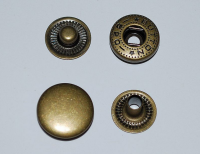








A snap fastener is a pair of interlocking discs, made out of a metal or plastic, commonly used in place of buttons to fasten clothing and for similar purposes. A circular lip under one disc fits into a groove on the top of the other, holding them fast until a certain amount of force is applied. Different types of snaps can be attached to fabric or leather by riveting with a punch and die set specific to the type of rivet snaps used (striking the punch with a hammer to splay the tail), sewing, or plying with special snap pliers.
Snap fasteners are a noted detail in American Western wear and are also often chosen for children's clothing, as they are relatively easy for children to use.
Invention
Modern snap fasteners were first patented by German inventor Heribert Bauer in 1885 as the "Federknopf-Verschluss", a novelty fastener for men's trousers. Some attribute the invention to Bertel Sanders, of Denmark. These first versions had an S-shaped spring in the "male" disc instead of a groove.Australian inventor Myra Juliet Farrell is also credited with inventing a 'stitchless press stud' and the 'stitchless hook and eye.'In America, Jack Weil (1901–2008) put snaps on his iconic Western shirts, which spread the fashion for them.